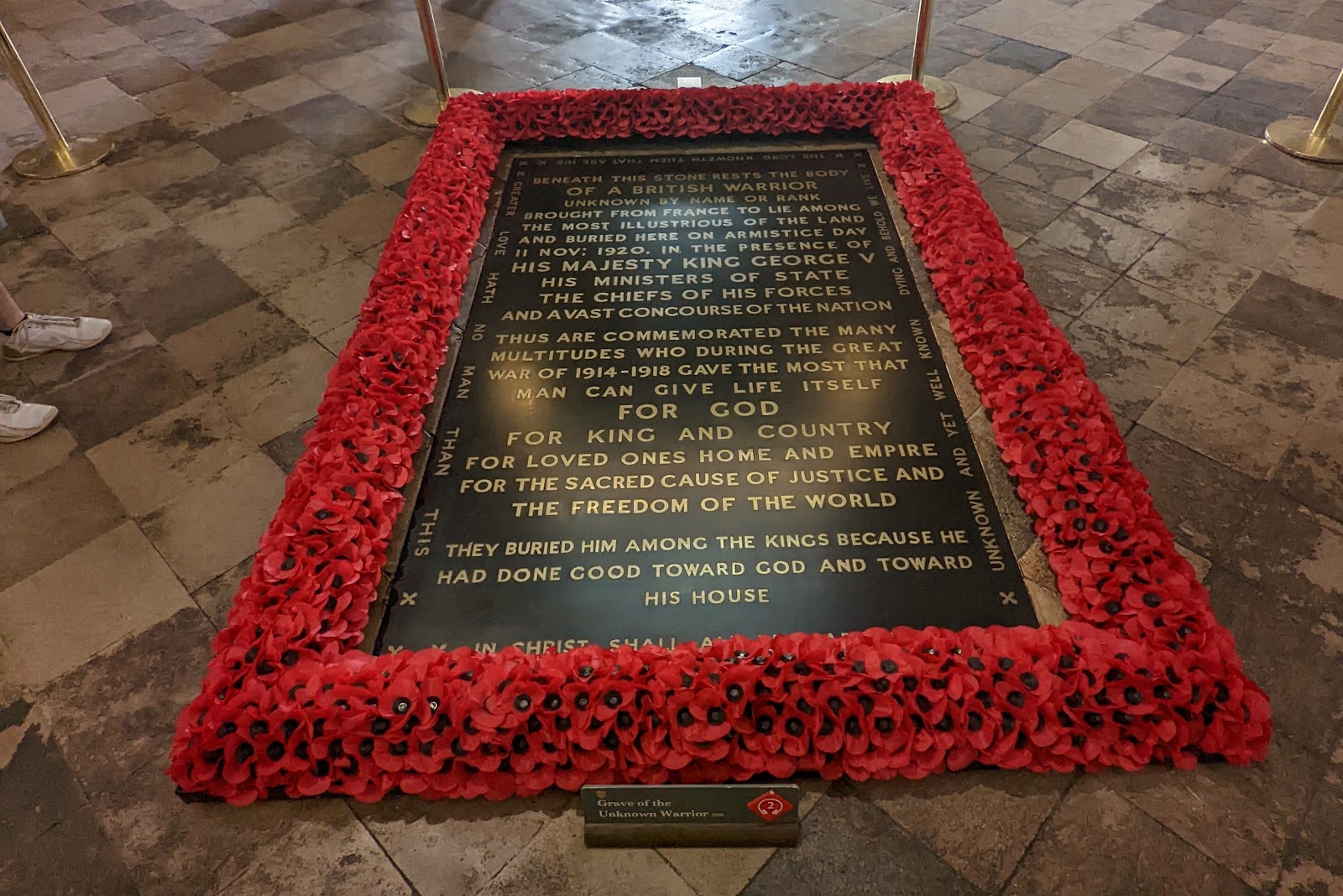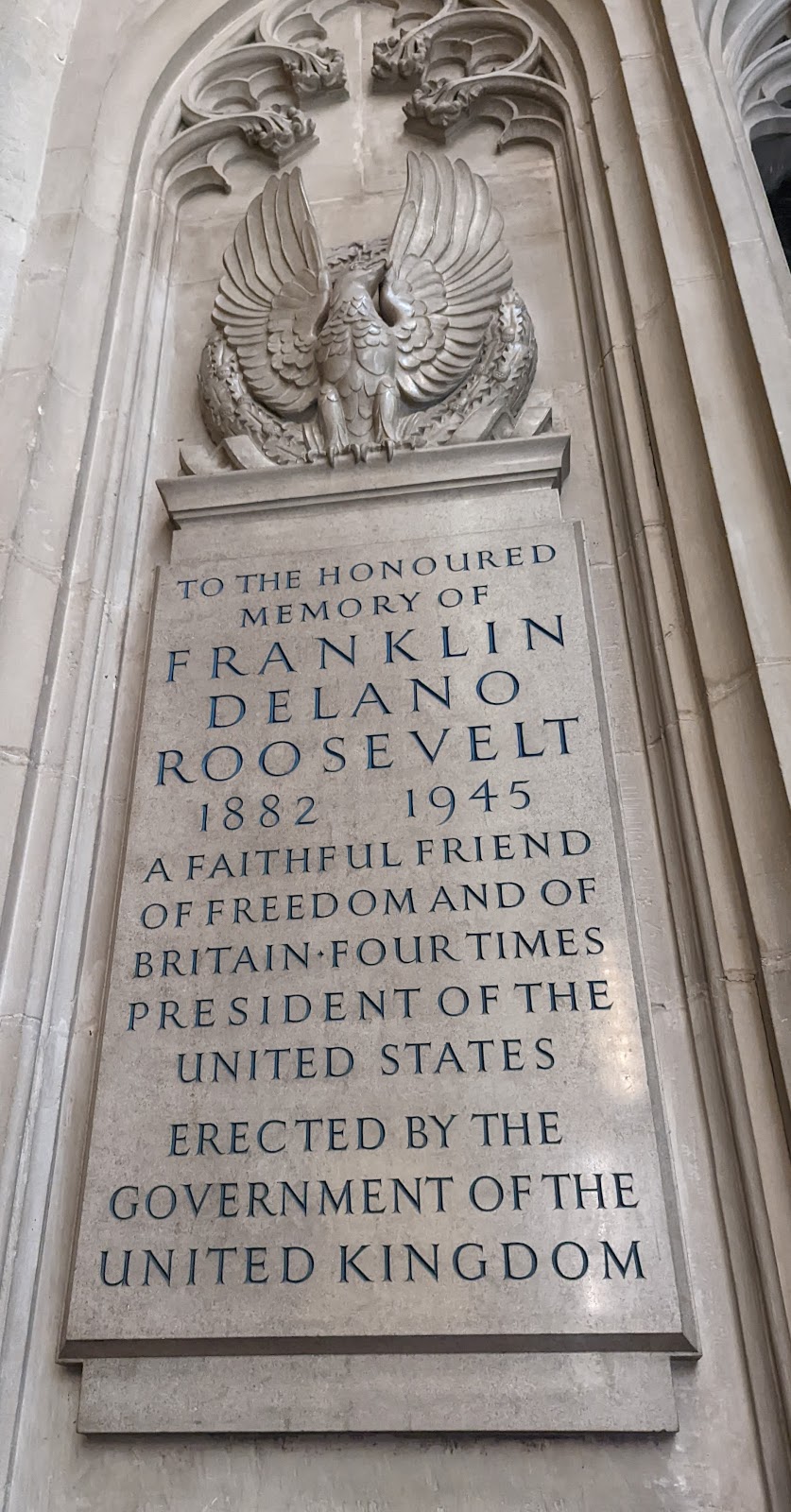 |
| Westminster Abbey May 2016 |
Westminster Abbey is a Royal Church with more than 1000 years of history. It's the site of coronations, royal weddings and resting place of kings, queens, statesmen, soldiers and poets.
According to the book, Westminster Abbey: A Thousand Years of National Pageantry, there have been 15 royal weddings and 38 coronations.
Benedictine monks founded Westminster Abbey in 960 CE. King Henry III initiated the current structure in 1245. The history is so extensive that I recommend looking at the details at westminster-abbey.org
In addition to daily worship services, which do not require tickets, visitors can obtain tickets to tour various parts of this grand church. It is a place to learn about art and history as well as a sacred place.
There are four gardens with limited open times.
Abbey tours include a multimedia guide with the tickets. You can also have a Verger-guided tour.
There are four gardens with limited open times.
Abbey tours include a multimedia guide with the tickets. You can also have a Verger-guided tour.
In 2022, we entered through the East doors.
Whilst waiting in line, there's a considerable amount of artistry to appreciate.
Once inside with audio guide attached, we look around. Above and below and one side to another people reveal how they have been inspired for centuries.
Approaching the table, you get the feeling that all are welcome. The church's embrace of science is nicely represented by the memorial to Sir Isaac Newton on the screen to the left.
 |
| Honouring Sir Isaac Newton |
The church honours many who have defended the nation. The memorial to the unknow warrior is a sacred place. Unlike other burial markers in our pathway, we do not tread upon this one buried with the soil from Belgium where so many British warriors fought two major wars with their allies against those who would destroy the freedom precious to humanity.
Moving on, we encounter the High Altar where the coronations have taken place for centuries.
Pictured below is the pavement in front of the High Altar ordered by King Henry II in 1268. The workers came from Rome to create this complex stonework called the Cosmati Pavement.
Click the link to view a video walking toward the nave, into the choir, and approaching the High Altar. YouTube
Westminster Abbey is a living church that fuses the past with the present. We are surrounded by the tombs of British monarchs. One such amazing edifice is the tomb of King Edward known as the Confessor for his faith.
Edward was born to King Ethelred and Emma in Oxfordshire about 1002. Danish invaders drove him into exile in Normandy. He pledged to make a pilgrimage to Rome upon his safe return. The pope released him from his pilgrimage vow to serve his people provided he honour St. Peter thus the new Westminster Abbey, which replaced the former Saxon church was consecrated on 28 December 1065. He was respected by his people for his piety and kindness. Sadly, he died shortly afterwards and was buried 6 January 1066.
I got a bit side tracked. The choir is incredible. So, here are some photos up and down plus the organ.
 |
| Choir |
 |
| above the choir |
A special chapel honours those who defended the nation against potential annihilation during the Battle of Britain. In addition to the RAF, Commonwealth and American pilots rose to the occasion and are remembered here.
Literary greats are remembered with monuments and plaques and some are buried in the Abbey. Poet's Corner is one famous alcove where many writers have inspired Britons for centuries.
 |
| Poet's Corner British Literature - a collage of memorials -- you will walk upon many markers throughout the church. |
Not everyone in the Abbey is British. On the wall is a memorial to a friend of the nation, US president Franklin Delano Roosevelt.
Before you exit, notice the tall structure on your left.
Around the corner, you can peak through the railing at the ancient Coronation Chair. The photo is not so great because of the protective shield reflecting the light.
This oaken chair is more than 700 years old. It is placed in front of the High Altar for the coronation service. The chair was ordered by King Edward I in 1300 to enclose the Stone of Scone, which the King brought to the Abbey from Scotland in 1296.
The chair has been used since 1308 when all the monarchs are crowned. So far, there have been 38 coronation ceremonies. The famous 336 pound Stone of Scone was used by the Scots for centuries. It's origin is buried in myth.
The Stone of Scone is now in Edinburgh Castle where I saw it a few days before visiting the Abbey. I had seen the chair above the Stone earlier. Prime Minister John Major announced the return of the Stone in 1996 and it was returned to the Scots 14 November. The stone is to be returned to the old chair for future coronations. According to the Abbey information, the Stone will be relocated by the Scots to Perth in a couple of years.
 |
| St Margaret's Church Plaque |
You can find several affordable books focusing on various aspects such as the history, art, or treasures of Westminster Abbey.
Old prints illustrate how Westminster Abbey looked in rural Westminster like this one from 1817 available on Amazon.
Travel notes
--subject to change by Westminster Abbey so, check their website
Underground: The Abbey is close to Westminster and St. James's Park stations.
Overground: Victoria and Waterloo stations are less than a mile away.
Buses- several buses serve the area.
Check the website for current information-in the past, you could...
Buy hot meals and snacks in the Abbey at the cafe near the exit.
Bring a packed lunch and eat in designated areas.
Purchase items from the Abbey shop and ship them worldwide.
BAGS: Bags are checked. Large items like suitcases and large rucksacks are not permitted.
WAIT TIMES: The wait times can be up to 1.5 hours during busy times of year such as May to September and during holidays. In 2022, timed tickets were available and recommended due to limited admissions.
Website https://www.westminster-abbey.org/
My website suttong.com
Bring a packed lunch and eat in designated areas.
Purchase items from the Abbey shop and ship them worldwide.
BAGS: Bags are checked. Large items like suitcases and large rucksacks are not permitted.
WAIT TIMES: The wait times can be up to 1.5 hours during busy times of year such as May to September and during holidays. In 2022, timed tickets were available and recommended due to limited admissions.
Website https://www.westminster-abbey.org/
My website suttong.com
Some very old pictures of Westminster Abbey
 |
| Westminster looking at the North Doors, 1980 |
 |
| Westminster looking north, 1980 |
 |
| Westminster Abbey South Cloisters |
 |
| Westminster Abbey Norman Undercroft |
 |
| Poet's Corner, West Minster Abbey |
You might like this fun and informative guide to British words and phrases.
Mind the Gap on AMAZON and GOOGLE
Related Posts
Visit London England
************************************
************************************
Links to Connections
My Page www.suttong.com
My Books AMAZON and GOOGLE STORE
FOLLOW
FACEBOOK Geoff W. Sutton TWITTER @Geoff.W.Sutton
PINTEREST www.pinterest.com/GeoffWSutton
Free Psychology Articles: Academia
Geoff W Sutton ResearchGate
Geoffrey W Sutton
*********************************************
Kings and Queens Buried in the Abbey
Kings and Queens of England
Edward the Confessor d 1066, Anglo-Saxon
House of Plantagenet
Henry III d 1272
Edward I d 1307
Edward II d 1377
Richard II d 1400
Henry V d 1422, House of Lancaster
Edward V d 1483, House of York
House of Tudor
Henry VII d 1509
Edward VI d 1553
Mary I d 1558
Elizabeth I d 1603
House of Stuart
Mary, Queen of Scots d 1587, Queen of Scotland
Kings and Queens of Great Britain and Ireland
James I d 1685
Charles II d 1685
Mary II d 1694
William of Orange d 1702
Anne d 1714
House of Hanover
George II d 1760
Famous Scientists Buried in Westminster Abbey
Sir Isaac Newton
J.J. Thomson
Lord Rutherford
Lord Kelvin
Robert Stephenson
Thomas Telford
William Herschel
John Herschel
Joseph Lister
Poets and Literary Figures Buried in Westminster Abbey
Geoffrey Chaucer 1400
Spenser
Ben Johnson
Dryden
Prior
Samuel Jonson
Sheridan
Browning
Tennyson
Other Literary Figures Recognised by Memorials
William Shakespeare
Robbie Burns
William Blake
Keats
Byron
Shelley
D.H. Lawrence
Oscar Wilde
Milton
Samuel Butler
Joseph Addison
William Congreve
Thomas Gray
Oliver Goldsmith
Samuel Taylor Coleridge
Robert Southey
William Wordsworth
Lord Macaulay
Thackeray
Charles Dickens
George Eliot
Thomas Hardy
Rudyard Kipling
Jane Austen
Charlotte Bronte
Emily Bronte
Anne Bronte
W. H. Auden
A.E. Houseman
Fanny Burney
Christopher Marlowe
Note
There is a lot of text here. I may have made a mistake and would like to provide accurate information. Kindly offer corrections in a comment along with a source.
Thank you




















Comments
Post a Comment